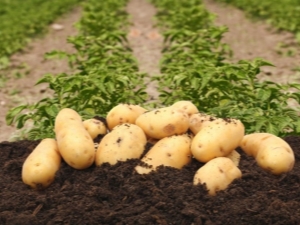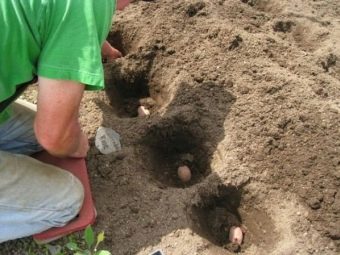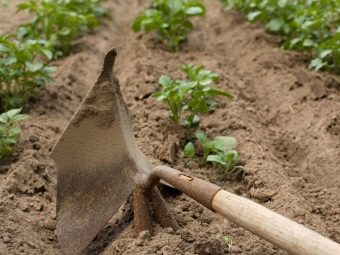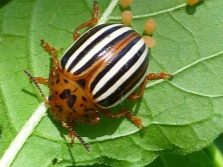Description and features of cultivation of potato "Colette"

The potato variety “Kolette” was created thanks to the close cooperation of German and Russian agronomists.This is a variety for early disembarkation, its growing season is 75 days. The maturation of the first tuber occurs already at 55-60 days from the moment of disembarkation. The plant dies off on the 80th day.
Under all conditions of cultivation and care, this variety can please with a crop of up to 250 centners from one hectare.
Special features
Potato variety "Kolette" is characterized by a low and erect shrub. Its sheets are small, bright green in color and soft waves along the edges. Blossom is expressed in the appearance of small inflorescences of purple size. From one bush on average you can expect about 10-15 fruits. All of them are of medium size, small fruits are extremely rare. One potato contains no more than 10% starch. We should also note that this variety can be stored for a long time. More than 90% of the harvest for the new season remains in its original form.
Among the advantages of the potato variety “Colette” are:
- bountiful harvest;
- good taste;
- excellent keeping quality;
- resistance to all sorts of diseases;
- uniform shoots shoots;
- the same size of all fruits;
- potato tuber smooth and smooth.
Despite the large number of advantages, this variety still has one significant drawback. Growing "Colette" is made exclusively on light fertile soil. Heavy soil will not give an opportunity to get a bountiful harvest, because the sprouts may simply not grow.
Description of the variety, as well as its characteristics, have only positive reviews.
Growing up
Potato variety "Colette" is an early. However, the timing of planting is influenced by the area where it is planned to grow potatoes. In the southern regions, you can sow potatoes in early May. But experienced gardeners warn that late and early planting can significantly affect the volume of the crop, so you should not rush to plant potatoes. For this variety, it is desirable to choose a plot with a light loamy or sandy soil. Also, the site should be open and accessible to the sun. In winter, open terrain is cleared faster from snow. For planting, select a day on which the air temperature will not be below +10 degrees. The earth should be warmed up, richly fed and wet.
Preparation for planting should be carried out in the autumn. Before the beginning of winter, it is desirable to dig up the ground well. This will allow to remove to the surface of harmful insects and their larvae deep in the ground, to remove the remaining grass, which can cause diseases. Winter frosts will destroy all insects dangerous for vegetable crops, and in the spring you will have to wait for the prepared soil. Digging in the spring should be accompanied by the addition of manure.
It is also recommended fertilizing the land in the form of superphosphate, which will provide the soil with the necessary dose of minerals, potassium and nitrogen.
Seed preparation
In order for the potato harvest to be abundant, most gardeners agree that planting already grown tubers is preferable to plant in open ground. It is recommended to germinate them in spring (February, March). For this, seed potatoes are laid out on the surface of a box or floor. Choose a warm and bright place for this, it will speed up the process.
For planting it is desirable to pre-select the tubers, the average weight of which does not exceed 80 grams. If there are larger tubers, cut them into several pieces. Humid air is desirable for germination, so it is recommended to create a greenhouse effect by yourself. To do this, place the potato tubers in the ground, mixed with sawdust. Add a small amount of water. Next, cover the box with a thin layer of film and leave until the first shoots appear.
When sprouts appear, it is advisable to immediately remove the film, allowing them to germinate on their own.
Landing
This potato variety is preferable to plant in the area with winter vegetable crops (annual grass, beans and flax). It is possible to plant a variety “Kolette” with such a “neighbor” as beans. It is noticed that if potatoes and beans grow together - the harvest of both is more abundant. It is also worth noting that this variety is permissible to be planted in one area for many years in a row, without worrying that the quality of the crop will decrease.
It is advisable to divide the previously prepared plot with burst and moistened soil into the required number of beds. This will facilitate the process of planting and the subsequent care of the potatoes. Do not forget that the soil must be well heated, otherwise the seeds of the potato will not take root. The hole is made at a depth of 5-10 centimeters. Put potato sprout up and slightly sprinkled with soil. The preferred spacing between potato bushes is 35 centimeters. Between the rows - about 60 centimeters.
Provided that the potato was planted in a favorable climate and in fertile soil, the first shoots can be observed in seven days.
Care
This variety is popular for its stable and abundant harvest. But in order to grow it, you need to spend a lot of time and effort. One of the main conditions for the cultivation of the variety “Kolette” is the presence of fertile soil, and therefore the monitoring of the composition of the soil should be a regular occupation. In the period when the potato shrub begins to bloom, it is recommended to closely monitor whether the plant has enough water.
The main and mandatory measures for the care of potatoes "Colette":
- Spud potatoes need at least three times for the entire season. In order to stimulate the growth of the stalks, it is advisable to spud the plant after the first shoots are seen. It is also recommended that you lightly sprinkle young sprouts with the ground, which will help protect the shoots at night from possible cooling. The remaining two hilling carried out with an interval of 14-20 days. It is preferable to do this after a shower. This will promote gas exchange in the ground.
- Break through the soil recommended after planting potatoes. Wait until the first shoots appear, there is no need. Thanks to this agrotechnical measure, the soil is saturated with air and the root system of potatoes begins to develop more actively. Breakaway soil is less susceptible to the emergence of weeds, the formation of an earth crust on the upper layer and favors the growth of the tuber. At first, it is desirable to loosen the soil, only slightly touching the upper layer, so as not to hurt the newly planted seed. It is possible to carry out a deeper loosening of the soil after the potato bushes grow. This will moisten the soil.
- Water the plant recommended only in dry and hot weather. Care must be taken to keep the ground moist but not wet. Otherwise, there is a high risk of fungal diseases.
- Feed the plant preferably 2-3 times for the whole season. It is preferable to introduce fertilizer before the potato bush begins to bloom. As a top dressing the most popular are “Nitrofozka”, “Mortar” and “Effecton”. The fact that the plant needs additional feeding can be determined visually. If the stem of the potato is thin and sluggish, it develops slowly - then the plant should be fed immediately. As soon as you notice the appearance of buds, it is necessary to produce a second plant feeding. Use ash and potassium sulphate as a fertilizer. The final dressing is made at the stage of the appearance of flowers. In this case, it is recommended to use superphosphate.
Diseases and pests
Despite the fact that the potato variety “Kolette” is not subject to the main list of diseases of vegetable crops, it is still recommended to carry out preventive processing of the root system and tubers.Poliram, Ordan, and Kurzat are used as therapeutic drugs. It is necessary to use these drugs strictly following the instructions.
Due to the fact that the root system is adversely affected by isolates and phytophtoras, it is advisable to spray the bushes with the help of the Kuproskat remedy with the calculation of 400 liters per hectare of land.
The most dangerous insects that can cause significant damage to the crop include:
- Colorado beetles. Dangerous because they lay a lot of eggs on the back of the leaves. After a couple of days, the larvae hatch and eat the fox bush bush. You can fight this pest by systematically removing them from the leaves and treating them with "Prestige", "Masterpiece" and "Batsikol".
- Wireworms. It is dangerous that they eat the fruit, making tunnels in them. Wireworms are very voracious, and therefore it is extremely difficult to get rid of them. It is better to combat this pest in spring or autumn when preparing the soil for planting. For example, in the spring, seven days before planting potatoes, it is recommended to establish "traps". To do this, take a few cups of plastic and fill them with sour cream and potato peel. Then dig them in shallow water. After a couple of days, the wireworms will crawl, after which they must be removed.
- Fluorimea. An extremely dangerous pest that "specializes" exclusively in potatoes. Gardeners often call it the potato moth. Dangerous because it multiplies rather quickly, producing a multitude of caterpillars that devour the leaves and even fruits located shallowly in the ground. You can get rid of them with the help of Iskra or by installing pheromone traps near the garden, which are sold in all garden stores.
How to get an early potato, see the next video.









































